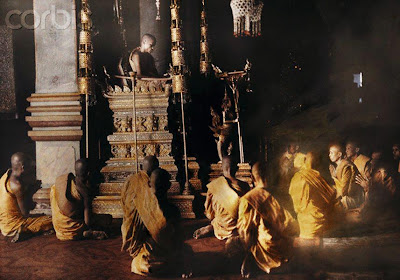Khmer Pagoda (Wat)
After the fall of Angkor, Buddhism (Hinayana) has been the formal religion in Cambodia in stead of Hinduism which was the dominant religion since the creation of Khmer State in the early 1st century under the leading of His Royal Majesty SORMA (King of Nokor Phnom-Khmer State) who later got married with King KORDIN from India. Therefore, Hinduism was brought by King KORDIN into Khmer State and it lasted until the end of Angkor Empire. It should be remarked that Buddhism (Mahayana) had also been one of the religion before and during Angkor Empire, too. The evidence for Buddhism (Mahayana) can be seen at Bayon Temple and other temples which were built by King Jayavarman VII such as Buddha statues, King Jayavarman VII statue sitting for concentration as Buddha, and sculpture on those temples in which most of them were damaged by some believers of Hinduism as violating the Buddhism (Conflict of Religion for short period of time in the end of Angkor Era). Buddhism of Mahayana and Hinayana were a bit difference in daily practice. However, since the Buddhism of Hinayana was more satisfied for Khmer people and the less reliability of Hinduism and Buddhism (Mahayana) in controlling the state losing documentations through the invasion from Siam State (Thailand), King of Khmer Kingdom and Khmer people changed to believe the Buddhism of Hinayana. Since then, there were a lot of pagodas and Buddhist statues built from the early of 15th century. Pagodas (in Khmer called Wat) were built of wood other than stone which was used for building temples in previous era, so it was the end of temple building in Cambodia. Exceptionally, most of Buddha statues were built of stone. Angkor Wat Temple which was built from 1113 to 1150 under the King Sorya Varman II was changed to be Buddhism pagoda and became a popular pagoda in Longvek Era (from the end of 15th to the end of 16th century). More importantly, the tradition of letting young man to be a monk has been beginning from that time until today. According to the tradition of Khmer nation, most of the young men had to live in pagoda as a month to learn the Pali Sanskrit, Buddha’s dharma, Khmer Literature, Khmer History, and the psychological education. Some men went to live in the pagoda since the youngest age to serve the monk until they became the adult in which they could be allowed to live as a monk in the pagoda for showing their gratefulness for ancestors and especially their parents. They learnt to be the leader for the country as the leader for their family in the future. All Khmer men who used to live as monk were seen as the polite and thoughtful men for women to depend on. Buddhism of Hinayana allowed Khmer people to gather good documentations from one generation to another generation by keeping in the pagoda. However, those documentations usually lost several times during the war with neighboring countries such as Siam State (from 15th to 19th century) and Vietnam State (from 17th to 19th century). Most of important documentations and valuable Buddhist statues were taken to Siam State through the invasion several times after the fall of Angkor Empire, especially during the invasion of Siam State on Khmer Kingdom in conquering Longvek Capital in 1594. Some of the left documentations were fired by both countries in the following regime. Even though there was less documentation and a lot of wars, Khmer people still did their best to protect and gathered their memory about Buddhism into documentations again. Under the French colonial, Buddhism was more secured and developed in good condition. After getting independence from France on November 9th, 1953, Buddhism was in the golden age until April 17th, 1975. Unfortunately, every thing related to Buddhism was seriously damaged in Pol Pot or Khmer Rouge Regime. Most pagodas were broken and some of them were considered as the place for storing rice, salt, and living place for pig, etc. Therefore, picture on the wall and ceiling of Khmer ancestors in ancient pagodas whose age was more than 100 years was affected in bad condition as the example of Kompong Trolach pagoda in Kompong Chhnang Province. Most of Buddhism documentations were completely fired and most of the monks were killed. For a few decades of these local wars in Cambodia, Buddhism reduced its influence on Khmer people’s believe since the practice of some monks today has been seeing weaker and weaker. As the result, some of residents in this generation still believe on Buddhist in mind other than some of the monks. However, the Buddhism practice and believe of Khmer people in some area of Cambodia, southeastern area of Thailand, Kampuchea Krom region (southern region of Vietnam), and in foreign countries is considered to be good. In short, there is optimism for better practice of Buddhism in Cambodia in the future as the golden age (1953-1975) and a hope for Buddhism management to take action to reform what is bad into good again. Buddhism is really important since it is the guideline for Khmer people. “If there is a change, Control it in good manner!”
By: POK Panhavuth






